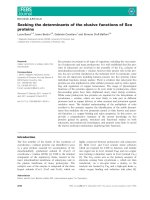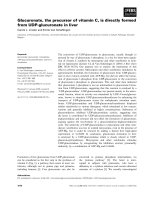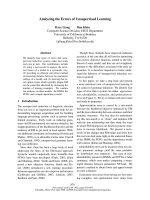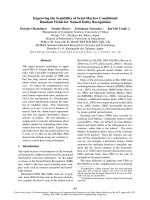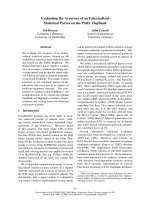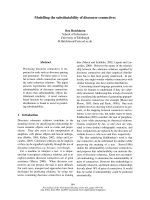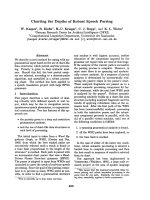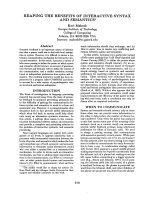báo cáo khoa học: " Using the theory of planned behaviour as a process evaluation tool in randomised trials of knowledge translation strategies: A case study from UK primary care" pot
Bạn đang xem bản rút gọn của tài liệu. Xem và tải ngay bản đầy đủ của tài liệu tại đây (330.88 KB, 9 trang )
RESEARC H ARTIC LE Open Access
Using the theory of planned behaviour as a
process evaluation tool in randomised trials of
knowledge translation strategies: A case study
from UK primary care
Craig R Ramsay
1*
, Ruth E Thomas
1
, Bernard L Croal
2
, Jeremy M Grimshaw
3
, Martin P Eccles
4
Abstract
Background: Randomised trials of knowledge translation strategies for professional behaviour change can provide
robust estimates of effectiveness, but offer little insight into the causal mechanisms by which any change is
produced. To illustrate the applicability of causal methods within randomised trials, we undertook a theory-based
process evaluation study within an implementation trial to explore whether the cognitions of prim ary care doctors’
predicted their test requesting behaviours and, secondly, whether the trial results were mediated by the theoretical
constructs.
Methods: The process evaluation comprised a cross-sectional questionnaire survey of a random 50% sample of the
randomised groups of primary care practices in Grampian (NHS Grampian), UK, who took part in a trial of the
effect of enhanced feedback and brief educational reminders on test requesting behaviour. The process evaluation
was based upon the Theory of Planned Behaviour and focussed on three of the test requesting behaviours that
were targeted in the trial – ferritin, follicle stimulating hormone (FSH), and Helicobacter Pylori serology (HPS).
Results: The questionnaire was completed by 131 primary care doctors (56%) from 42 (98%) of the sampled
practices. Behavioural intention, attitude, and subjective norm were highly correlated for all the tests. There was no
evidence that perceived behavioural control was correlated with any of the other measures. Simple linear
regression analysis of the rate of test requests on minimum behavioural intentions had R
2
of 11.1%, 12.5%, and
0.1% for ferritin, FSH, and HPS requesting, respectively. Mediational analysis showed that the trial results for ferritin
and FSH were partially mediated (between 23% and 78% mediation) through intentions. The HPS trial result was
not mediated through intention.
Conclusions: This study demonstrated that a theory-based process evaluation can provide useful information on
causal mechanisms that aid not only interpretation of the trial but also inform future evaluations and intervention
development.
Introduction
Randomised trials of knowledge translation (KT) strate-
gies for professional behaviour change can provide
robust estimates of e ffectiveness, but offer little insight
into the causal mechanisms by which any change is pro-
duced. This would not be an issue if interventions had a
uniform effect across differe nt conditions that could be
generalised to all practitioners outside of the trials.
However, the effects of interventions do appear to vary
by condition, professional group, and context, presum-
ably because the causal mechanisms of th e interventions
are modified in the presence of different barriers and
enablers [1]. Therefore the interpretation of a trial and
assessment of its likely generalisability would be
enhanced if additional information was obtained about
the causal mechanisms through which the intervention
* Correspondence:
1
Health Services Research Unit, University of Aberdeen, Foresterhill,
Aberdeen, AB25 2ZD, UK
Full list of author information is available at the end of the article
Ramsay et al. Implementation Science 2010, 5:71
/>Implementation
Science
© 2010 Ramsay et al; licensee BioMed Central Ltd. This is an Open Access article distributed under the terms of the Creative Commons
Attribution License ( which permits unrestricted use, distribution, and reproduction in
any medium, provided the original work is properly ci ted.
worked, and how the effect was modified in the pre-
sence of different barriers and enablers.
There is increasing recognition of the value of process
evaluations alongside trials of complex interventions
such as professional behaviour change interventions.
The behavioural sciences have developed and operatio-
nalised theories concerned with the determinants of
behaviour and behaviour change [2]. These standard
definitions of constructs and measurement m ethods
may be useful for exploring causal mechanisms of inter-
ventions and barriers and enablers to KT. Theory-based
process evaluations are a relatively new method being
proposed to collect data on theoretical constructs along-
side randomised trials to explore possible causal
mechanisms [3]. This is akin to measuring intermediate
endpoints in clinical trials to further understand the bio-
logical basis of any observed effects (for example, mea-
suring cholesterol alongside trials of lipid-lowering
drugs where the primary endpoint could be reduction in
vascular related deaths). Different theories will be rele-
vant to interventions at different levels; for example,
psychological theories will likely be more relevant to
interventions directed at individuals and teams, while
theories of organisational change will be more relevant
to interventions directed at hospitals or o ther large
organisations.
We undertook a randomised controlled trial (RCT) [4]
using a 2 × 2 factorial design to evaluate the effects of
feedback of requesting rates enhanced with educational
messages, and brief educational reminder messages,
alone and in combination on UK primary care doctors’
requesting of nine potentially overused laboratory tests.
Practices that received either or both the enhanced feed-
back and the reminder messages were significantly less
likely than the control group to request the targeted
tests in total. The effe ct of the interventions varied
across the targe ted tests individually, although the gen-
eral pattern showed a reduction in the number of tests
requested for both interventions. Neither intervention
was consistently better than the other. To investigate
possible causal mechanisms, we conducted a post inter-
ventionsurveyusingthetheoryofplannedbehaviour
(TPB) about the use of three of the targeted laboratory
tests – the measurement of serum ferritin in the assess-
ment of microcytic anaemia (ferritin), the measureme nt
of serum follicle stimulating hormone (FSH) in the
assessment of menopausal status, and the measurement
of Helicobacter Pylori serology (HPS) following eradica-
tion therapy. Therefore, the aim of the study was to
undertake a theory-based process evaluation study to
explore whether the cognitions of general practitioners
predicted their test requesting behaviours and secondly,
whether the trial results were mediated by the theoreti-
cal constructs.
Methods
Description of the main trial interventions
Feedback consisted of a six-sided colour booklet (e.g.,
see Additional File 1) presenting graphs of practice level
data for each of the nine targeted tests and for each
laboratory discipline as a whole. Every graph showed
rates of test requesting over the previous three years for
the practice compared with the regional rates. The feed-
back was enhanced with brief educat ional messages that
described specific clinical circumstances where it was
inappropriate to request the test. These messages were
included alongside the graphs for each of the targeted
tests. The booklets were posted to each primary care
doctor within each intervention group practice on four
occasions (updated every three months from the start of
the intervention period).
The brief educational messages were added as remin-
ders to the test result reports sent to the requesting
practice (e.g., see Additional File 2). The laboratory
information system was programmed to recognise the
relevant cues for each of the targeted tests and automa-
tically add the brief educational reminder messages to
the relevant printed and electronic test result reports.
The messages were activated every time the cue
occurred and were presented at the same time as the
test result. The reminder messages were intended to
influence future requests for the targeted tests.
Choice of theory
The process evaluation was based upon TPB (Figure 1)
[5,6]. TPB is the social cognition model that has been
widely used to predict individual behaviours [7,8] and
has been one of the theories used most often when
exploring the determinants of professional behaviour
[9]. The theory states that an individual’sintentionto
perform a behaviour is the proximal predictor of beha-
viour. In turn, intention is pred icted by attitude (a per-
son’s overall evaluation of the behaviour), subjective
norm (a person’s own estimate of the social pressure to
perform or not perform the target behaviour), and per-
ceived behavioural control (the extent to which a person
Figure 1 The Theory of Planned Behaviour (Ajzen, 1991).
Ramsay et al. Implementation Science 2010, 5:71
/>Page 2 of 9
feels able to enact the behaviour; it has two aspects: how
much a person has control over the behaviour and how
confident a person feels about being able to perform or
not perform the behaviour). Perceived behavioural con-
trol also has a direct effect on behaviour.
Study design and population
The process evaluation comprised a cross-sectional
questionnaire survey of a random 50% sample of the
randomised groups of primary care doctors in Grampian
(NHS Grampian), UK, who took part in a trial of the
effect of enhanced feedback and brief educational
reminders on test requesting behaviour. The random
sampling was performed by a statistician independent of
the research team.
We focussed the process evaluation on three of the
test-requesting behaviours that were targeted in the trial
– serum ferritin, FSH, and HPS – to reflect the varying
effectiveness of the interventions. The choice of these
tests reflected a range of effectiveness of the interven-
tion. Whilst they were requested at similar rates prior to
the intervention, following the intervention there were
statistically significant reductions in the requesting of
FSH, non-statistically significant reductions in Ferritin
requesting and HPS requesting was unaffected.
Data collection
Measures of the determinants of behaviour
We developed a direct measur e TPB questionnaire to
measure the determinants of the primary care doctors’
test requesting behaviour [10]. W e used standard
worded items for each of four TPB constructs; intention,
attitude, subjective norm, and perceived behavioural
control, with three to five items contributing to each
construct. The questionnaire was in three sections each
corresponding to one of the three tests. At the start of
each section, a brief scenario described the clinica l pro-
blem that had been targeted by the brief educational
messages. Primary care doctors were then asked to rate
their intention, attitude, subjective norm, and perceived
behavioural control related to requesting a specific test
in the described scenario on a 7-point Likert scale (ran-
ging from 1 ‘strongly agree’ to 7 ‘strongly disagree’). The
scenarios and examples of items (questions) for each
construct are detailed in Table 1, and a full copy of t he
questionnaire can be seen in Additional File 3.
The survey took place 12 months after the initiation
of the interventions. A questionnaire plus reply paid
envelope was posted to each primary care doctor, with
one reminder sent to non-responders two weeks later.
Measures of behaviour
For each of the targeted test, the test requesting rate per
1,000 patients (standardised by practice list size) at 12
months post-intervention was used as the measure of
behaviour in each primary care practice. The numbers
of the three tests requested and the requesting practices
for the 12 months of the intervent ion period were
downloaded from the NHS Grampian laborato ry infor-
mation system. This data are routinely collected and
ascribed to the primary care practice and could not
accurately be attributed to individual primary care
doctors.
Statistical analysis
In all statistical analyses, the three targeted tests are
reported and analysed separately. In order to test the
representativeness of our s ample from within the trial
practices, the mean difference in test-requesting beha-
viour between sampled and non-sampled primary care
practices was compared using a t-test.
Table 1 Scenario details and examples of questionnaire items by construct
Scenarios
FSH: Next week a woman aged 47 presents with hot flushes and night sweats having missed three of her last six periods (menopausal
symptoms).
Helicobacter pylori serology: Next week a patient comes to see you with symptoms of dyspepsia. You saw this patient three months ago,
and prescribed antibiotics to eradicate helicobacter pylori which had been detected using a breath test
Ferritin: Next week a patient returns to see you who presented complaining of tiredness. The result of his Full Blood Count (FBC) test
shows a microcytic anaemia pattern (low MCV, low haemaglobin, low red cell count).
TPB Constructs Example questions
Behavioural intention (three
questions)
I intend to request an FSH test to assess menopausal status in this woman - Strongly Agree/Strongly disagree
Attitudes (four questions) I think that requesting a Helicobacter Pylori serology (HPS) test to assess efficacy of antibiotic therapy for
eradication of helicobactor pylori in this patient is generally - Helpful/Unhelpful
Subjective norms (four questions) Most general practitioners would request a Ferritin test to assess iron deficiency in this patient - Strongly Agree/
Strongly disagree
Perceived behavioural control (five
questions)
There are factors outside my control that would prevent me from requesting an FSH test for this patient -
Strongly Agree/Strongly disagree.
Ramsay et al. Implementation Science 2010, 5:71
/>Page 3 of 9
Scale generation
On the assumption that the tests were not necessary,
responses for each of the four constructs were scaled
from one to seven so that a high score on every con-
struct (e.g. 7) equated with a low intention to request a
test, a negative attitude towards requesting a test, a low
perception of social pressure to request a test, and a
high control over whether or not tests were requested.
For every primary care doctor, a score for each con-
struct in the TPB model was calculated as the mean of
all items contributing to the construct. Cronbach’s alpha
was used to ascertain the reliability of each of the scales.
If reliability was lower than 0.7, an exploratory factor
analysis was performed to ide ntify any unreliable items
and unreliable items were removed from the scale.
Scale summaries
General descriptive statistics were used to summarise
each scale and an intra-cluster correlation [11] was esti-
mated to describe the degree of clustering of cognitions
within each primary care practice. Pearson correlations
were produced between all the scales. Multiple linear
regressions of intention on attitude, subjective norm and
perceived behavioural control were performed to iden-
tify significant predi ctors (2P < 0 .05). To correct for the
clustering within practic e in the multiple regression
models, the Huber-White estimator of variance inflation
was used [12].
Predicting test requesting using intention
To predict the strength of the relationship between
intention and behaviour, because the behaviour data
were at a practice level, a summary measure of intention
for each practice had to be calculated. This was gener-
ated in two ways – by taking the mean intention per
practice (i.e., the average intention of all primary care
doctors within a practice), and by taking the minimum
intention per practice (i.e., the lowest intention score
from any respondent within a practice). The minimum
represented the lowest intention in each practice to do
the correct behaviour (not request a test). The mini-
mum was pro posed as a possible summary measure
because the severe negative skewness of the intention
measures suggested that the poorest intention to per-
form the behaviour might be a better correlation with
actual practice performance. Linear regressions were
performed of behaviour on mean (or minimum) inten-
tion. For all analyses, effects were reported with corre-
sponding 95% confidence intervals and the R
2
statistics
were reported.
Mediation analysis of trial result using intention
Summary descriptives of each TPB construct together
with the behavioural outcome (test request rate per
1,000) were tabulated by randomised group. To estimate
the strength of the mediation of intention on test
requesting behaviour, a simple mediation model was
setup with the trial group (reminders versus no remin-
ders) as the predictor of behaviour and intention as the
mediator (see Figure 2 Mediation Model). A bootstrap-
ping method of estimating the indirect effect of inten-
tion was used [13], and the estimated percentage of the
effect mediated through intention was reported. The
same model was run for feedback versus no feedback.
Results
The survey sample
The questio nnaire was sent to 232 primary care doctors
in 43 practices. One hundred and thirty-one primary
care doctors (56%) responded from 42 practices (33 pri-
mary care doctors from 10 control practices, 32 from 11
feedback practices, 31 from 10 reminders practices and
35 from 11 practices receiving both interventions). The
mean requesting rate per 1,000 patients for each tar-
geted test was similar in sampled and non-sampled
practices (ferritin: 11.9 versus 15.8, p = 0.152; FSH: 10.1
versus 11.2, p = 0.474; HPS: 11.5 versus 11.5, p = 0.975).
TPB constructs
The reliabilities of the behavioural intention, attitude,
and subjective norm scales were greater than 0.70
(Table 2). For perceived behavioural control, exploratory
factor analysis demonstrated that one question (how
likely is it you would be able to request a ferritin/FSH/
HPS in this patient?) was poorly correlated with the
other items on the scale thereby reducing the reliability.
When this item was removed, the reliabilities improved
to the values shown in Table 2.
Figure 2 Mediation Model - Intervention group as the
predictor of behaviour, intention as the mediator. The direct
effect of the intervention allocation on behaviour is the coefficient
C in the path diagram above. The indirect effect (often called the
mediated effect) hypothesises that the observed intervention effect
is due to a causal relationship whereby the intervention allocation
“causes” the mediator variable (intention) to change and that in
turn “causes” the behaviour to change. The indirect effect is
therefore the product of the coefficients A and B in the statistical
model and the direct effect is C. The strength of the mediation is
determined by the difference between the direct minus indirect
effect.
Ramsay et al. Implementation Science 2010, 5:71
/>Page 4 of 9
Summary statistics for each construct are shown in
Table 2. Behavioural intention, attitudes, and subjective
norms were at simi lar levels within ferritin test request-
ing (medians approximately equal to four ) and similar
within FSH test requesting (medians approximately
equal to five). Perceived behavioural control had a med-
ian >6.0 for both ferritin and FSH test requesting. For
HPS test requesting, all scales had median >6.0 suggest-
ing a potential ceiling effect. Most of the intra-cluster
correlations were >0.1, suggesting that primary care doc-
tors had m ore similar cognitions to those in their own
practice than to primary care doctors in other practices.
Behavioural intention, attitude, and subjective norm
were highly correlated for all the tests (Table 3). There
was no evidence that perceived behavioural control was
correlated with any of the other measures. Multiple lin-
ear regression analyses demonstratedthatattitudeand
subjective norm were predict ive of intention for ferritin,
FSH, and HPS requesting (Table 4). Perceived beha-
vioural control was statistically significant for only the
HPS requesting, but the R
2
for that model was lower
than the others and intention had a clear ceiling effect
suggesting the model fit was suboptimal and therefore
unreliable.
Predicting the rate of test requests
Simple linear regression analysis of the rate of test
requests on mean behavioural intentions had R
2
of 8.5%,
7.7% and 0.1% for ferritin, FSH, and HPS, respectively
Table 4). Replacing the mean intention per practice with
the minimum intention per practice improve d the R
2
to
11.1%, 12.5% and 0.1% for ferritin, FSH, and HPS,
requesting respectively. The low R
2
for the HPS-
requesting models was primarily due t o a ceiling effect
on intention generating little variability in the indepen-
dent variables.
Mediation analysis of trial result using intentions
Summary descriptives of each TPB construct are
described by trial allocation in Table 5. For ferritin and
FSH test requesting, there was a suggestion that the
mean intention, attitude, and subjective norm differed
Table 2 Summary statistics of TPB construct scales across all respondents
N = 131 Mean Median SD Minimum Maximum ICC Reliability
Ferritin
Behavioural intention 3.98 4.00 1.90 1.00 7.00 0.11 0.99
Attitude 3.97 4.00 1.63 1.00 7.00 0.16 0.97
Subjective norm 4.76 4.75 1.19 2.00 7.00 0.11 0.79
Perceived behavioural control 6.24 6.50 0.83 3.75 7.00 < 0.001 0.75
FSH
Behavioural intention 5.07 5.83 1.66 1.00 7.00 0.17 0.99
Attitude 5.02 5.25 1.39 1.00 7.00 0.14 0.98
Subjective norm 4.86 5.00 1.17 2.00 7.00 0.03 0.82
Perceived behavioural control 6.14 6.37 0.86 2.75 7.00 0.08 0.70
HPS
Behavioural intention 6.38 7.00 1.11 1.00 7.00 0.03 0.98
Attitude 6.26 7.00 1.17 1.00 7.00 0.15 0.92
Subjective norm 6.00 6.00 1.02 2.25 7.00 0.15 0.80
Perceived behavioural control 5.94 6.00 1.03 2.75 7.00 0.07 0.79
Table 3 Correlations (Pearson’s r) between TPB scales
across all respondents
Behavioural
intention
Attitude Subjective
norm
Ferritin
Attitude 0.91** -
Subjective norm 0.77** 0.76** -
Perceived behavioural
control
-0.11 -0.16 -0.01
FSH
Attitude 0.91** -
Subjective norm 0.69** 0.60** -
Perceived behavioural
control
-0.07 -0.05 0.02
HPS
Attitude 0.76** -
Subjective norm 0.73** 0.72** -
Perceived behavioural
control
-0.16 -0.10 -0.07
** Correlation was sig nificant at 2P < 0.01
Ramsay et al. Implementation Science 2010, 5:71
/>Page 5 of 9
between the intervention groups. For HPS requesting, all
TPB constructs were skewed towards the positive end of
the scales, suggesting very little variation b etween
responses.
The results of the mediation analysis are shown in
Table 6. The direct result was the trial effect (i.e., the
difference in mean test requesting between the interven-
tion and co ntrol groups). For example, reminders
reduced the rate of ferritin test reques ting by 1.33. Note
in contrast to the main trial, none of the direct results
were statistically significant because only 50% of prac-
tices were in the process evaluation. The indirect effect
was the difference in trial effect of the intervention
when behavioural intention was included and excluded
from the model. For example, behavioural intention
reduced the effect of reminders on ferritin tests by 0.39,
resulting in 29% of the effect of the reminders being
mediated through intention . For ferritin and FSH, the re
wassomeevidencethatthetrial effects were partially
mediated by behavioural intentions. For HPS test
requesting, there was a clear ceiling effect in behavioural
intention making the mediation analysis unreliable.
Discussion
This study demonstrated that TPB can be used as a tool
for theory-based process evaluations with the aim of
investigating possible causal mechanisms in KT inter-
vention studies when the intervention is hypothesised to
Table 4 Predictors of behavioural intentions and
behaviour using multiple regression
Coefficent* (95% CI) p-value R
2
Predictors of intentions
Ferritin 86%
Attitude 0.91(0.80, 1.02) < 0.001
Subjective norm 0.29 (0.11, 0.48) < 0.01
Perceived behavioural control -0.08(-0.19, 0.04) 0.203
FSH 86%
Attitude 0.94 (0.81, 1.06) < 0.001
Subjective norm 0.33 (0.14, 0.51) < 0.01
Perceived behavioural control 0.12 (-0.05, 0.28) 0.156
HPS 65%
Attitude 0.46 (0.10, 0.81) 0.013
Subjective norm 0.41 (0.12, 0.71) 0.008
Perceived behavioural control -0.10 ( 20, 00) 0.048
Predictor of behaviour
Ferritin
Intentions -1.78 (-3.59, 0.03) 0.061 8.5%
FSH
Intentions -0.82 (-1.70, 0.06) 0.075 7.7%
HPS
Intentions 0.28 (-1.98, 2.54) 0.808 0.1%
* Coefficient interpreted as the change in intentions (or behaviour) for each
unit change in the construct (predictor)
Table 5 Summary of scales and behaviour by trial allocation
Behavioural
Intention
Perceived
Behavioural
Control
Subjective Norm Attitude Rate per 1000
test requests
Median (IQR) Median (IQR) Median (IQR) Median (IQR) Mean (sd)
Test Requested:
Ferritin
Control group 2.7 (2.0, 4.3) 6.3 (5.8, 7.0) 4.3 (3.5, 5.0) 3.25 (2.0, 4.0) 13.4 (6.7)
Feedback only group 4.3 (3.0, 6.0) 6.0 (5.3, 7.0) 5.0 (3.9, 5.8) 4.5 (3.6, 5.6) 11.8 (5.3)
Reminders only group 4.0 (2.1, 6.0) 7.0 (6.0, 7.0) 5.0 (4.0, 6.0) 4.0 (2.3, 5.2) 15.2 (14.6)
Both group 5.0 (2.9, 6.0) 6.3 (5.5, 7.0) 6.4 (5.8, 7.0) 4.5 (3.0, 5.3) 7.6 (3.6)
FSH
Control group 4.3 (2.7, 6.0) 6.0 (5.8, 6.8) 4.2 (3.5, 5.2) 4.2 (3.2, 5.5) 11.3 (3.9)
Feedback only group 5.6 (4.3, 6.0) 6.5 (5.5, 7.0) 4.9 (4.2, 5.5) 5.2 (4.5, 6.0) 10.1 (2.7)
Reminders only group 6.0 (5.0, 7.0) 6.5 (6.0, 6.9) 5.2 (3.9, 5.9) 5.5 (4.7, 6.2) 9.6 (3.9)
Both group 6.0 (5.0, 7.0) 6.3 (5.5, 7.0) 5.2 (4.7, 5.9) 5.7 (4.9, 6.1) 9.5 (4.0)
HPS
Control group 6.3 (6.0, 7.0) 5.8 (4.9, 6.5) 6.0 (5.5, 7.0) 7.0 (5.7, 7.0) 10.7 (4.9)
Feedback only group 7.0 (6.0, 7.0) 5.8 (5.0, 7.0) 6.0 (5.5, 6.0) 7.0 (6.0, 7.0) 13.6 (6.8)
Reminders only group 7.0 (6.0, 7.0) 6.8 (6.0, 7.0) 6.2 (5.0, 6.9) 7.0 (6.0, 7.0) 10.7 (4.6)
Both group 7.0 (7.0, 7.0) 6.0 (5.5, 7.0) 6.3 (5.8, 7.0) 7.0 (6.0, 7.0) 10.9 (5.9)
PBC = Perceived Behavioural Control
Ramsay et al. Implementation Science 2010, 5:71
/>Page 6 of 9
be mediated by the constructs of TPB. There were dif-
ferences in intention, attitude, and subjective norm to
FSH and ferritin test requesting, suggesting that the
intervention may have enhanced attitudes and subjective
norms resulting in higher intention and subsequent
behaviour changes. Indeed, mediational analysis was
highly suggestive that the differences in test requesting
behaviour between trial groups were mediated through
intention. There were high intentions, subject ive norms,
and attitudes for HPS requesting, suggesting that there
may have been a psychological ceilin g effect resulting in
the observed lack of effect on test requesting behaviour
in the trial.
This study had several strengths. First, the main trial
demonstrated strong intervention effects (behaviour
change), so provided an ideal platform to investigate
why change did or did not occur. In particular, the ran-
domisation element provided the opportunity to
robustly investigate whether intentions mediated the
trial result. Second, use of a well-established psychologi-
cal model (TPB) enabled the psychological constructs to
be clearly defined. Third, the derived measures of psy-
chologi cal constructs were sensitive to group allocatio n,
suggesting that the constructs were identifying real dif-
ferences. Finally, the TPB survey was returned com-
pleted from 42 of the 43 practices, suggesting that the
results were generalisable.
The mediational analysis suggested that intentions to
request an FSH or ferritin test were part of the causal
pathway in the trial, i.e., the observed trial reduction in
test requesting was partially mediated by a change in
intentions. In our experience, formal mediational ana-
lyses have been rarely used to investigate the causal fac-
tors in KT randomised trials, and we suggest
investigators should make more use of theory-based
process evaluations.
Given that responses were received from several pri-
mary care doctors within a practice, we were able to
demonstrate that there was clustering of psychological
constructs within practices. Behavioural intentions and
attitudes to test requesting had intra-cluster correlations
greater than 0.1. This clustering provided some empiri-
cal evidence that s ocial or organisational factors within
practices may influence test-requesting behaviour. The
clustering also needs to be considered from a statistical
power perspe ctive when conducting such surveys in the
future. The effects of clustering are that precision is
reduced and confidence intervals are wider than if clus-
tering were not present. The surveys therefore need a
larger sample size to attain the level of precision that
investigators are interested in [14].
Whilst nearly all practices (42/43) were represented in
the final survey, only 56% of the primary care doctors
within those practices responded. This response rate
from individual primary care doctors is very similar to
that of other surveys of health professionals [15]. We
cannot however be sure that the responders’ views are
representative of the practice, but the response rates
were the same across the trial intervention groups sug-
gesting that the results were not biased. Further, use of
different measures of aggregated practice intention acted
as a form of sensitivity analysis on the influence of dif-
ferent aggregation methods on the study results [16].
In this study, our behavioura l outcome was practice
level test requesting. Ideally, to operationalise TPB
model faithfully, the outcome would be individual prac-
titioner-level requesting. A multi-level model analysis
could then be used to account for any clustering of
behaviour or behavioural predictors by practice. How-
ever, it was not possible to obtain data on individual pri-
mary care doctors’ requesting patterns from the
admini strati ve data systems. The implication for statisti-
cal analysis was that some measure of practice-level psy-
chological cognitions had to be derived. An obvious
summary measure is the mean cognition of the primar y
care doctors within each practice [16]. Using the mean
cognition, intentions predicted about 8% of the variab il-
ity in FSH and ferritin testing. Because the psychological
Table 6 Mediational analysis of intentions on trial result
Ferritin FSH HPS
Mean (95% CI) Mean (95% CI) Mean (95% CI)
Main effect:
Reminders
Direct effect -1.33 (-6.78, 4.11) -1.11 (-3.35, 1.12) -1.37 (-4.87, 2.13)
Indirect effect -0.39 (-2.70, 1.22) -0.86 (-2.53, 0.19) 0.21 ( 44, 1.47)
Percentage effect mediated by intentions 29% 77% 0%
Enhanced Feedback
Direct effect -4.57 (-9.85, 0.70) -0.66 (-2.91, 1.60) 1.55 (-1.94, 5.05)
Indirect effect -1.31 (-3.66, 0.16) -0.15 (-1.19, 0.50) -0.10 (-1.44, 0.83)
Percentage effect mediated by intentions 28% 23% 0%
Ramsay et al. Implementation Science 2010, 5:71
/>Page 7 of 9
measures were generally high with little variability, an
alternative summary measure (the minimum) was con-
sidered. The minimum predicted about 12% of the
variability in FSH and ferritin testing. The observed lack
of relationship between HPS testing behaviour and
intentions to request was likely due to the ceiling effect
in intentions, but could also be due to the insensitivity
in the behavioural measure. That is, whilst the interven-
tion (and therefore the scenario description in the ques-
tionnaire) targeted requesting of the tests in specific
clinical circumstances, the information system cannot
distinguish between specific clinical circumstances (e.g.,
for HPS repeat testing after eradication therapy, the
measure of behaviour was all HPS test requests because
the information system cannot distinguish between
initial tests, repeat-tests, and does not identify the rea-
sons for the request). Therefore, our dependent variable
may not exactly match the context of the intervention
and scenario. Our findings and future investigations of
causal mechanism would be strengthened by individual,
context specific, measures of behaviour. We would
recommend that researchers consider conducting a sen-
sitivity analysis on any summary measure of psycho logi-
cal cognitions when attempting to describe a group level
behaviour [16]
No formal statistical power calculation was performed
for the survey. The confidence intervals for the testing
oftheconstructsthatwerepredictiveofintentions
(Table 3) and the models predicting behaviour-using
intentions (Table 4) demonstrated the study was ade-
quately powered to detect impo rtant effects. For the
results of the mediational analysis the study was under-
powered. This was due mainly to only 50% of the origi-
nal study practices taking part in the survey. This meant
that the original study findings on test-requesting beha-
viour could not be replicated with the same preci sion
(though the magnitude of effects were similar). We
would recommend that future studies of mediational
factorsinKTtrialsconductaformalsamplesizeto
ensure adequate power for the theory based process
evaluation.
We investigated behavioural predictors at one time
point after initiation of the interventio n i.e., the survey
was conducted after the study interventions had been
delivered for 12 months. In this example, the difference
in constructs scores between intervention and control
practices were large and provided evidence of changes
in construct. Future process evaluations may be aug-
mented by the addition of pre-intervention measures of
behavioural predictors. Furthermore, the results of this
study provide some evidence that TPB could be used to
design an intervention. The ceiling effect on the inten-
tion to request HPS tests suggests that an intervention
targeting a primary care doctors’ inte ntion to request
the test would likely fail. In the context of the trial
reported here, this would have suggested that feedback
and reminders might not have been effective interven-
tions to use and that was indeed the trial finding.
The aims of process evaluation alongside randomised
trials of complex interventions are numerous (e.g., fide-
lity of implementation; mechanisms, mediators, and the
process of change; acceptabili ty) and often encompass a
range of methods [17-19]. There are few RCTs of pro-
fessional behaviour change strategies that utilise theory
to investigate the process of change [20]. Whilst TPB
seems to be the most commonly applied social cognition
model for investigating health professional behaviour,
few studies have attempted to predict clinical-related
behav iour [9]. The results of this process evaluation uti-
lising theory, re-enforces that TPB seem an appropriate
theory to predict health professional behaviour change
[9], and that it may offer useful insight into the pro-
cesses underlying change (trial effects) in KT trials [17].
Summary
Recognition of the KT gap has led to increased interest
in more active KT strategies. E xisting research demon-
strates that professional behaviour change interventions
can be effective, but the effectiveness of interventions
appears to vary across different clinical problems, con-
texts, and organisations. This study demonstrated that a
theory-based process evaluation can provide useful
information on causal mechanisms that aid not only
interpretation of the trial but also can inform future
evaluations and intervention development. We encou-
rage researchers to conduct and further develop meth-
ods for exploring causal mechanisms alongside rigorous
evaluations of different strategies.
Additional material
Additional file 1: Example of the feedback intervention.
Additional file 2: Example of the reminders intervention.
Additional file 3: The TPB questionnaire.
Acknowledgements
We thank Anne Walker for contributing to the design of the questionnaires.
The Health Services Research Unit is funded by the Chief Scientist Office of
the Scottish Government Health Directorate. Ruth Thomas was funded by
the Wellcome Trust (GR0673790AIA). Bernard Croal was supported by a
grant from Grampian Endowments. Jeremy Grimshaw holds a Canada
Research Chair in Health Knowledge Transfer and Uptake. The views
expressed are those of the authors and not necessarily of the funding
bodies.
Author details
1
Health Services Research Unit, University of Aberdeen, Foresterhill,
Aberdeen, AB25 2ZD, UK.
2
Department of Clinical Biochemistry, Aberdeen
University Medical School, Polwarth Building, Aberdeen, AB25 2ZD, UK.
3
Clinical Epidemiology, Ottawa Health Research Institute; Department of
Ramsay et al. Implementation Science 2010, 5:71
/>Page 8 of 9
Medicine, University of Ottawa, Ottawa, Canada.
4
Institute of Health and
Society, Newcastle University, Baddiley-Clark Building, Richardson Road,
Newcastle upon Tyne, NE2 4AX, UK.
Authors’ contributions
All authors conceived the original trial. JMG and MPE conceived the theory
based process evaluation. All authors contributed to the design of the study.
CR and RT were responsible for running the project. CR was responsible for
the statistical analyses. All authors interpreted the data and findings. CR
wrote the first draft of the manuscript, all authors read and approved the
final manuscript.
Competing interests
MPE is an editor of Implementation Science, but has had no editorial
responsibility for this manuscript. All other authors have stated no
competing interests.
Received: 7 December 2008 Accepted: 29 September 2010
Published: 29 September 2010
References
1. Grimshaw JM, Thomas RE, Maclennan G, Fraser C, Ramsay CR, Vale L,
Whitty P, Eccles MP, Matowe L, Shirran L, Wensing M, Dijkstra R,
Donaldson C: Effectiveness and efficiency of guideline dissemination and
implementation strategies. Health Technol Assess 2004, 8:(6).
2. Michie S, Johnston M, Abraham C, Lawton R, Parker D, Walker A, on behalf
of the ‘’Psychological Theory’’ Group: Making psychological theory useful
for implementing evidence based practice: a consensus approach. Qual
Saf Health Care 2005, 14:26-33.
3. Grimshaw J, Zwarenstein M, Tetroe J, Godin G, Graham I, Lemyre L,
Eccles MP, Johnston M, Francis JJ, Hux J, O’Rourke K, Legare F, Presseau J:
Looking Inside the Black Box: A Theory Based Process Evaluation
Alongside A Randomised Controlled Trial Of Printed Educational
Materials (The Ontario Printed Educational Message (OPEM)) Trial Study
Protocol. Implementation Science 2007, 2:38.
4. Thomas RE, Croal BL, Ramsay CR, Grimshaw JM, Eccles MP: The effect of
enhanced feedback and reminder messages on laboratory test
requesting. Lancet 2006, 367:1990-6.
5. Ajzen I: Attitudes, personality and behaviour. Milton Keynes: Oxford
University Press 1988.
6. Ajzen I: The theory of planned behaviour. Organizational Behaviour and
Human Decision Processes 1991, 50:179-211.
7. Armitage CJ, Conner M: Efficacy of the theory of planned behaviour: a
meta analytic review. B J Soc Psychol 2001, 40:471-99.
8. Webb TL, Sheeran P: Does changing behavioural intentions engender
behavior change? A meta-analysis of the experimental evidence. Psychol
Bull 2006, 132:249-268.
9. Godin G, Bélanger-Gravel A, Eccles M, Grimshaw J: Healthcare
professionals’ intentions and behaviours: A systematic review of studies
based on social cognitive theories. Implementation Science 2008, 3:36.
10. Francis JJ, Eccles MP, Johnston M, Walker A, Grimshaw JM, Foy R, Kaner EFS,
Smith L, Bonetti D: Constructing questionnaires based on the theory of
planned behaviour: a manual for health services researchers. The EU
REBEQI project 2004 [ />11. Kerry SM, Bland JM: The intracluster correlation coefficient in cluster
randomisation. BMJ 1998, 316:1455-60.
12. Long JS, Ervin LH: Using heteroscedasticity consistent standard errors in
the linear regression model. Am Stat 2000, 54:217-24.
13. Preacher KJ, Hayes AF: SPSS and SAS procedures for estimating indirect
effectsin simple mediation models. Behavior Research Methods,
Instruments, and Computers 2004,
36:717-31.
14. Kish L: Survey Sampling. New York: John Wiley & Sons 1965.
15. Cook JV, Dickinson HO, Eccles MP: Response rates in postal surveys of
healthcare professionals between 1996 and 2005: An observational
study. BMC Health Serv Res 2009, 9:160.
16. Eccles MP, Hrisos S, Francis JJ, Steen N, Bosch M, Johnston M: Can the
collective intentions of individual professionals within healthcare teams
predict the team’s performance: developing methods and theory.
Implementation Science 2009, 4:24.
17. Francis JJ, Eccles MP, Johnston M, Whitty P, Grimshaw JM, Kaner EFS,
Smith L, Walker A: Explaining the effects of an intervention designed to
promote evidence-based diabetes care: a theory-based process
evaluation of a pragmatic cluster randomised controlled trial.
Implementation Science 2008, 3:50.
18. May CR, Mair FS, Dowrick CF, Finch TL: Process evaluation for complex
interventions in primary care: understanding trials using the
normalization process model. BMC Family Practice 2007, 8:42.
19. Oakley A, Strange V, Bonell C, Allen E, Stephenson J, RIPPLE Study: Process
evaluation in randomised controlled trials of complex interventions. BMJ
2006, 332:413-6.
20. Davies P, Walker AE, Grimshaw JM: A systematic review of the use of
theory in the design of guideline dissemination and implementation
strategies and interpretation of the results of rigorous evaluations.
Implementation Science 2010, 5:14.
doi:10.1186/1748-5908-5-71
Cite this article as: Ramsay et al.: Using the theory of planned
behaviour as a process evaluation tool in randomised trials of
knowledge translation strategies: A case study from UK primary care.
Implementation Science 2010 5:71.
Submit your next manuscript to BioMed Central
and take full advantage of:
• Convenient online submission
• Thorough peer review
• No space constraints or color figure charges
• Immediate publication on acceptance
• Inclusion in PubMed, CAS, Scopus and Google Scholar
• Research which is freely available for redistribution
Submit your manuscript at
www.biomedcentral.com/submit
Ramsay et al. Implementation Science 2010, 5:71
/>Page 9 of 9
